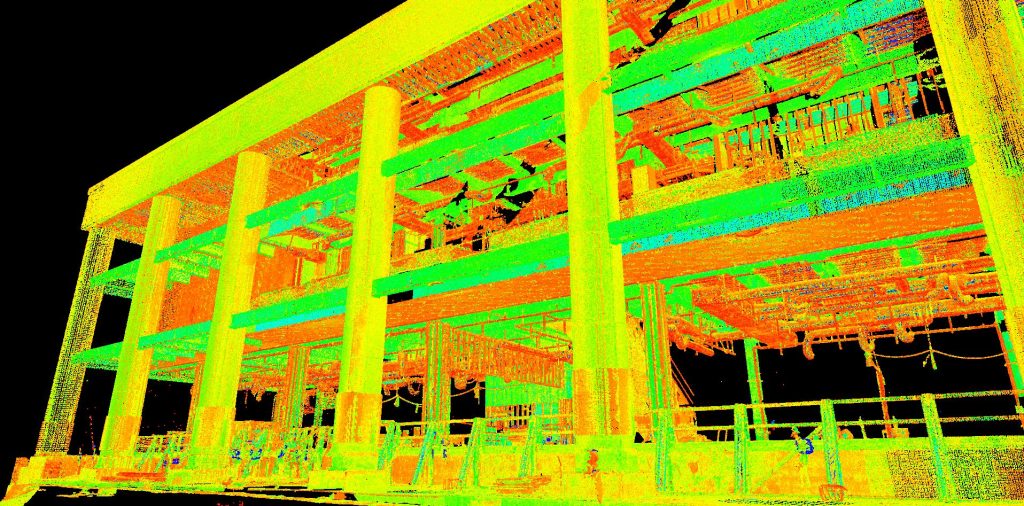The old-school way of capturing location data within a building relies on legacy tools like distance meters and notepads, a slow process and ripe for human error

Things move as the building goes up. Concrete grows and shrinks. Structures settle. Users can’t rely on outside points, because as the building shifts, those do too. That means each floor needs a fresh scan to account for differences.
Survey layout with 3D laser scanning technology changes all of that. The solution empowers users to gather, track, evaluate and analyze accurate physical data in a virtual environment.
3D laser survey and layout technology is faster, easier and more precise — and doesn’t require multiple trips to the job site. The system enables users to get exact MEP placement on each floor, and to easily maintain control on each subsequent floor.
The technology streamlines workflows with a unified one-person rig, called a total station or multistation. Consisting of a total station on a tripod, story pole or range pole with a prism, and a mounted computer, the station is highly portable and easily deployed on different floors and at varying job sites. Laser scanning is used to collect large amounts of data in the field and used as a time stamp or as-built scenario.
How it works
A crewmember places the unit in the corner that offers the best perspective of the survey area. Then the total station locates each control point and uses light and radar to measure and chart distances, inclines and angles. The procedure is repeated for at least two control points on the deck.
The unit triangulates the points and notifies the user if it’s in tolerance or not, so the crew knows whether to reshoot or proceed to identifying and locating hangers, sleeves and penetrations on the deck. The total station allows the user to layout or collect one point at a time. The 3D scanner collects millions of points and produces a high definition project point cloud that can be used to reference at a later date.
Benefits
Frequently used for surveying outside the building, the technology has benefits for trades working inside, too:
- More accessible data. Collect a complete virtual record of everything that the eye can see. Hangers, sleeves and penetrations, stub-ups, cable trays, and other points are identified and imported into the model, which is available on-site and back at the office. When the layout data is integrated into a BIM system, users gain visibility into every aspect of every project. Store important information like fixtures used; install, replacement, and repair dates; warranties; and more.
- Fewer errors, less rework, and reduced risk. Lasers deliver 1/8-inch accuracy depending on distance, meaning fewer return trips to job sites because of missed dimensions or incorrect measurements. This reduces gas, vehicle and labor expenses; maximizes work time; and lowers expenses related to reorders. The technology also helps mitigate risk. Overhead scans can be taken from the floor — no more climbing on ladders or scaffolding. And fewer truck rolls keep vehicles and crews off the roads, decreasing the potential for accidents that impact insurance premiums, reduce available headcount and even trigger fines.
- Less time and labor costs. Contractors want to get on the deck as soon as possible to lay out piping, plumbing, and electrical penetrations to put in holes before concrete is poured. Survey layout with 3D scanning lets them get ahead of the process. Using a robotic total station on the deck alleviates the need for two crewmembers — the person carrying the prism pole has a computer on board. By some estimates, crews can trim onsite data-capture time by as much as 50% to 70% over traditional surveying. And the more accurate data can be used for prefabrication and coordination, significantly slashing rough-in times.
- Multiple uses. Digitized survey layout technology has uses beyond the planning phase. It can also be deployed prior to project hand-off to establish as-built coordinates. This is especially valuable since MEP contractors frequently continue to work in the building after occupancy. It’s also useful when working on renovations and upgrades, offering the power to quickly and precisely document conditions before design or construction commences.
How to choose an MEP layout solution
Technology investments can be capital-intensive, so it’s critical to select a solution that provides the most upside. When evaluating options, look for a package that:
- Meets the firm’s specific needs. Sit down with field and office staff to get a clear understanding of the functions and capabilities. Focus the discussion on current and anticipated needs. Ensure that the solution meets the needs of other areas of the company, such as survey control. If the company is planning to expand, verify each potential solution’s ability to easily and cost-effectively scale with growth.
- Integrates and operates with existing solutions. Make a list of the current hardware and software — including BIM — to ensure that the existing tech stack meets each solution’s requirements. Scanning and layout solutions require powerful hardware, and point clouds use a lot of storage, so make sure that there is extra processing power, network performance and cloud capacity as needed. Explore compatibility with solutions used by general contractors and other frequent partners to ensure easy collaboration and data transfer.
- Provides training and support pre- and postsale. New technology requires different skills, so it’s vital to get sufficient training and support from the solution vendor. Review case studies and talk to other MEP contractors about providers with proven track records in the specialty. On- and off-site instruction is a must-have. Confirm that a sales engineer will be assigned to the account to get the team up and running. And don’t forget to find out how each solution provider handles ongoing tech support and system upgrades.












